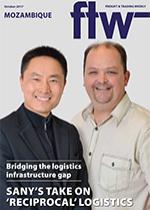Maputo has a new landmark
– the Maputo-Catembe
bridge – which will be the longest
suspension bridge in Africa when
it opens in around a year’s time.
Once the bridge is open work
will start on the 30-year vision
of the Catembe urbanisation
masterplan, which will see
the development of a modern
and sustainable city divided
into residential, commercial,
industrial, logistics, tourism, and
green areas.
There will also be a new
logistics and tourism link between
Natal and Maputo following the
tarring and upgrading of the
120-kilometre road between
Maputo and the Mozambican
border with South Africa at Kosi
Bay/Ponto do Ouro border post.
In many ways the bridge and
planned Catembe city development
are a metaphor for Mozambique.
They are one of a kind in
Africa, they are ambitious, and
there does not seem to be any
coordinated drive to maximise the
opportunities they open up.
Starting with ambition –
Mozambique has no shortage of
grand plans and opportunities.
For the past decade
Mozambique has had one of the
fastest growing economies in the
world (7.4% average), but the gap
between the rich and poor has
not changed, and the country
ranks 181st out of 187 in the World
Human Development Index.
Despite the potential of
economic development
created by
the discovery of massive gas and
coal deposits and the agricultural
potential of the country, its score
dropped by 33% between 2015
and 2016.
Mozambique certainly has the
potential for inclusive economic
growth to transform the country
within a very short space of time.
Other natural resources
include bauxite,
titanium,
hydropower,
tantalum,
graphite and
fisheries. There
are plans for the
exploitation of all
of these resources, but the process
is long and challenging – not least
because of a lack of infrastructure
and mountains of red tape.
The bridge is perhaps the
most visible indication that the
country’s logistics infrastructure
is being upgraded. There
is substantial investment
in roads, rail, ports and
telecommunications.
But much more can be done
to tell the rest of the world that
Mozambique is a viable gateway
to neighbouring countries and its
own hinterland.
Part of the
problem is that some operators
are still pricing services as
though they are still a monopoly.
In fact, most of the corridors
and ports face stiff competition
from neighbouring Tanzania
and South Africa, as well as
Namibia on the other side of the
continent.
Another factor is that the
private and
public sector
stakeholders
in the logistics
sector do
not seem to
be working
together.
Here the bridge is an excellent
example. This year FTW asked
almost all the people we met
in Maputo to talk about the
elephant in the room – what
impact will the bridge have on the
port and the flow of goods?
Will it provide a road link
to Durban that replaces the
Maputo container terminal which
is in the shadow of the structure,
or will it attract cargo from
South Africa? Everyone
we spoke to
had (differing) opinions, but
clearly it is not being discussed at
industry-level.
Certainly, the new road
positions Maputo to serve
northern Natal and to provide
an alternative for Gauteng traffic
through Komatipoort.
But that will need a
coordinated effort on the part
of the Mozambican logistics
community (and its South
African counterparts) together
with customs on both sides of the
border.
If the new road is to be nothing
more than a tourism corridor
then there has to be a one-stop
border post, and South Africa
needs to match investment on its
side of the border.
The same story can be told
with the upgrade of the Beira-
Zimbabwe road, the Tete-Nacala
railway, and numerous other
upgrades.
The opportunities are there –
but not for those looking for
quick returns.
INSERT
7.4% The average growth of the Mozambican
economy over the past decade.
CAPTION
Joining the dots – a view of the bridge under construction from inside the port of Maputo.
Bridging the logistics infrastructure gap
11 Oct 2017 - by Ed Richardson
0 Comments
FTW Mozambique 2017

11 Oct 2017
11 Oct 2017
11 Oct 2017
11 Oct 2017
11 Oct 2017
11 Oct 2017
11 Oct 2017
11 Oct 2017
11 Oct 2017
11 Oct 2017
Border Beat
Featured Jobs
New
New
